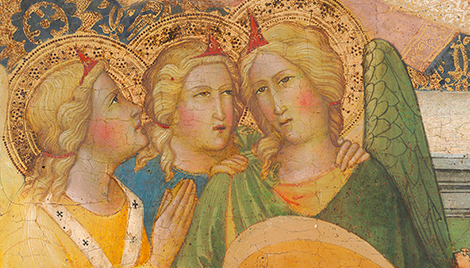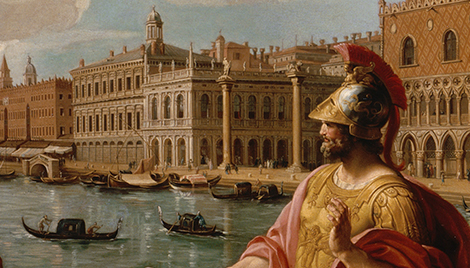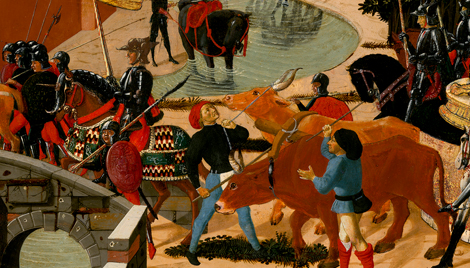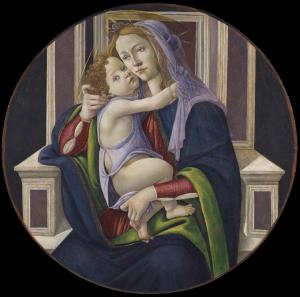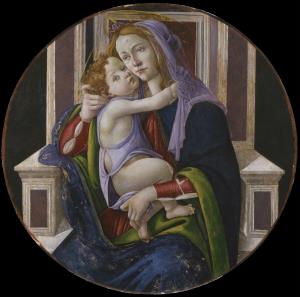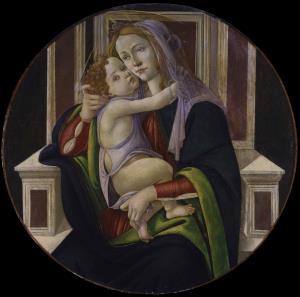Madonna and Child
Madonna and Child
- Artist
- Workshop of Sandro Botticelli
- Artist Dates
- 1446-1510
- Artist Nationality
- Italian
- Title
- Madonna and Child
- Date
- 1490s
- Medium
- tempera on panel
- Dimensions
- mean diameter: 84.5 cm (33-1/4 in)
- K Number
- K1240
- Repository
- El Paso Museum of Art
- Accession Number
- 1961.1.13
- Notes
Provenance
Baron de la Vandeuvre, Paris, by 1874. [1] Grasset Collection, Paris. Comte de Sarty, Paris; acquired 21 May 1907 by (F. Kleinberger Galleries, Paris and New York); sold 1925 to (Duveen Brothers, New York); [2] sold to Samuel H. Kress [1863-1955] gift 1943 to the National Gallery of Art; deaccessioned 1959 and returned to the Samuel H. Kress Foundation; gift to El Paso Museum of Art, no. 1961.1.13. [1] Lent to the Exposition des Alsaciens-Lorrains, Palais de la Présidence du Corps Legislatifs, Paris, 1874, no. 671. [2] Kleinberger Gallery stock card no. 7670, Department of European Paintings, Metropolitan Museum of Art.
Catalogue Entry
Workshop of Sandro Botticelli
Madonna and Child
K1240
EI Paso, Tex., El Paso Museum of Art (1961-6/11), since 1961.(1) Wood (probably rectangular originally). Mean diameter 33 1/4 in. (84.5 em.). Good condition except for slight abrasions. This type of Madonna, with the faces of Mother and Child pressed together in an impulsive gesture of affection and apprehension, was developed by Botticelli in his late period, probably between 1500 and 1510, when he had come under the influence of Savonarola and was looking back to the mystically religious sculptures of Donatello. There are a number of variants of the composition and it is often difficult, as in the case of K1240, to determine whether they are close enough to the master to have been executed in his studio.(2) Provenance: Comte de Sarty, Paris. Baron de Vandeuvre, Paris –exhibited: 'Exposition des Alsaciens-Lorrains,' Palais de la Presidence du Corps Legislatifs, Paris, 1874, no. 671, as Botticelli. Duveen's, New York (Duveen Pictures in Public Collections of America, 1941, no. 105, as Botticelli) –exhibited: 'Old Masters,' Detroit Institute of Arts, Mar. 22-Apr. 4, 1926, no. 7, as Botticelli; 'Old and Modern Masters,' Detroit Institute of Arts, Oct. 1927, no. 8, as Botticelli; 'Primitives,' Knoedler Galleries, New York, Feb. 16-Mar. 2, 1929, no. 6, as Botticelli. 'Italian Paintings from the XIV to XVI Century,' Detroit Institute of Arts, Detroit, Mich., Mar. 8-30, 1933, no. 23, as Botticelli. Kress acquisition, 1940 –exhibited: National Gallery of Art, Washington, D.C. (535), 1941-58.(3)
References
(1) Catalogue by F. R. Shapley, 1961, no. II, as Botticelli. (2) K1240 has been attributed to Botticelli by A. Venturi (in L'Arte, vol. XXVII, 1924, pp. 194 f.; Botticelli, 1925, pp. 58 f.), C. Gamba (Botticelli, 1937, pp. 181 f.), J. Mesnil (Botticelli, 1938, p. 163), and B. Berenson (in ms. opinion), who later (1955) doubted the attribution, which appears as accepted, however, in the posthumous edition of his Florentine lists (vol. I, 1963, p. 34). K1240 is attributed to the school of Botticelli by R. van MarIe (Italian Schools of Painting, vol. XII, 1931, p. 230) and R. Salvini (Tutta la pittura del Botticelli, 1958, p. 77), who plausibly suggests that it may be by the same hand as the Madonna formerly in the Trotti Collection, Paris, which Salvini reproduces in his pl. 151B. (3) Preliminary Catalogue, 1941, pp. 29 f., as Botticelli.

